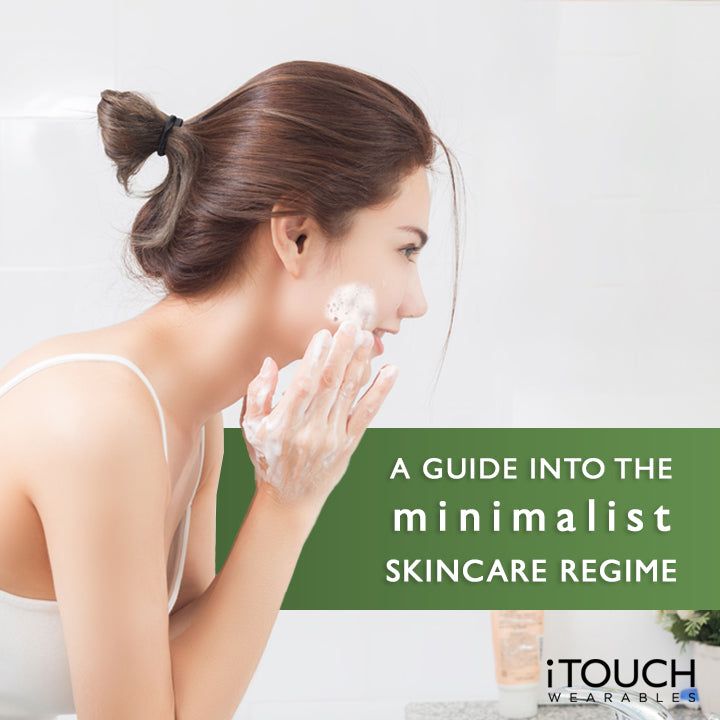
A Guide Into The Minimalist Skincare Regime
Over the past few years, the American beauty industry was booming with a trend known as K-Beauty (or Korean Beauty). There was a lot to be thankful about from the trend - creating an alarming, and most importantly, and impressive response that sent the industry ablaze with millennials and beauty gurus alike wanting a part of it. K-Beauty sky-rocketed the love for face masks, toners, exfoliators, and moisturizers, which in response, caused people to ultimately strive to reach the unmatched and unattainable goal for perfect skin. The scientifically back-up cast of products that feature that of peptides, acids, solutions, and other things with clinical sounding names have been sold in small but expensive packages, forcing people to spend thousands to create their ideal regime.
I was one of those people - I strived to create a routine that fit for my acne-prone and super sensitive skin. I looked into multiple different brands, buying products that seemed trendy and interesting amongst my friends and other millennials like me (Glossier anyone? - do not get me wrong though, I did love me some Boy Brow), but the more repeated use from these products, the more I found my skin to somewhat just plateau. In even trying to dip my face into the K-Beauty trends, I found that my skin would either dry out too much from repeated use and become more sensitive then it was. I can simply say that my skin is different from everyone else's, but in the end, everything that seemed to present me with the idea of perfect skin just turned out to be a scam. And honestly, it has to be, right? These things cannot actually cause you to have perfect skin can they - perfect skin doesn't exist?
Are More Products Actually Could For You?

In doing research for this article, I have found many stories from women and men that detailed their experiences when it came to their beauty routine. In may cases, it was found that people went down the "more, more, more" route, combining multiple products at once to create the best regime they can. For example, one woman, Aurora Hinz, who had acne-prone sensitive skin, had said that at the peak of her skincare regime, she had a mix ten products, most of which she used on a daily basis - "I used two face washes, a toner, a serum, two moisturizers, sheet masks, an exfoliant, and two over-the-counter acne treatment products," she described. She would spend up to $50 on one product alone to ensure she was making the best use out of her skincare regime.
Another woman, Elena Politiski, was in a similar situation. She spent several hundreds of dollars on skincare products to aid her rosacea. She was convinced that the more she'd spend on products, the more they'd help her skin.
Both women found the same result - that after a few months of use, nothing appeared to work despite their promises for clearer, smoothier, more vibrant skin. The two women went to dermatologists after their failed attempts, being told that their products wouldn't do a thing to help them or their skin issues. You cannot blame them for trying though! It is easy to get caught up in the marketing and advertising schemes the beauty industry as come up with to sell the idea of perfect skin tp consumers.
When it comes to skincare however, no one can be surely aware of when it became such a trendy thing. Many researchers do believe that starting with the K-Beauty trend is a good place to start. The K-Beauty industry made its way into the United State in 2015, only becoming more popular as the years went on. The promotion of the routine can be said to have become mainstream due to social media's use of influencers, beauty-gurus, but Western journalism tends to be the biggest component.
What is interesting though, is that Western journalism often got their facts wrong about K-Beauty. In an article found on the New York Times, Korean-American author Euny Hong writes about her experiences with the beauty industry, recounting her early life in Seoul and their use of beauty products. She tells the story of how the beauty industry in Seoul and Korea was almost non-existent, especially during South Korea's development within the late 70's and 80's has a third-world country. Many women within South Korea who could afford make-up and skincare products used American or French products, never being interested in K-Beauty products. No one there had even heard of a 12-step regime. The K-Beauty Skincare Regime was a product of the late 90's economic expansion of South Korea into the pop-culture market.
Is Less Actually More?

It is shocking to hear that these regimes do not work or are, possibly, built on marketed romance copy, storytelling, or a fallacy. While there may be some truth behind the system or each individual step, many people are now finding that the K-Beauty Skincare Regime is actually worsening their skin, damaging the skins natural protecting barriers from the extensive use of product. Dr. Marnie Nussbaum (MD), a top dermatologist in New York City, has said that
"I have patients who arrive at their initial consultation with a large bag full of products they either use never, sporadically or all at once. Because of that, they can't tell which one is the problem and those that are actually working for them."
When you are using that many products, especially the amount that are often used within a Korean Beauty Skincare Regime, you are actually canceling out the effects that each product is doing while you are exacerbating your skin. So in wanting to find the right fit for your skincare regime, Dr. Marnie Nussbaum and several dermatologists suggest "Marie Kondo-ing" your routine - meaning, that "less is more." Find what products actually bring you "joy" - meaning what actually helps bring results, while getting rid of the others that don't. The two specific products that are recommended for everyone to use, no matter what your skin type is, are toners and SPFs.
Finding What Works For You - Your Routine

Within my research, these are routines designed by leading dermatologists and skincare experts such as Dr. Marnie Nussbaum and Renée Rouleau. You will find routines made for dry skin, acne-prone skin, combination skin, and sensitive skin - having at most four products for each skin type.
Dry Skin:
If you suffer from dry skin, Rouleau suggests using products that are beneficial in rehydrating and renewing your skin. Within your routine, you want to at least incorporate one exfoliator, as it can help clear away any dead skin cells. It is also recommended that your throw away or get rid of any products that are high in certain alcohols, as they can cause you skin to become even drier. To make the most of your routine, uses these products:
- Gentle Face Cleansers - Use a cleanser that is gentle and creamy, as they are great formulas for dry skin. It is highly recommended that you stay away from sulfate-based foaming face washes, as the additives contain a high pH level that can dry your skin even more.
- Serums - Most serums contain lactic acid, which is a skin-smoothing, moisture barrier-repairing exfoliant. Ingredients such as lactic acid are important in serums as they can replenish your skin's natural moisture, helping to aid your skin's dryness.
- Moisturizers - It is important to find a moisturizer that can repair that natural barriers of your skin. Do not focus on finding a heavy moisturizer, but one that contains ingredients that mimic your skins natural lipid layer, such as sunflower oils, primrose oils, jojoba oils, almond oils, or even carrot oils.
Acne-Prone Skin:
For acne-prone skin, it is said that you should include the following into your skincare regime:
- Gel Cleanser - Avoid using a harsh, acne-focused cleanser (unless told to by a dermatologist) as they can be loaded with heavy chemicals and detergents that can damage your skin. In it said to use an anti-septic gel cleanser instead as it can help to decongest your pores while nourishing your skin. It will also offer anti-inflammatory benefits to help relieve your acne.
- Alcohol-Free Toner - Toning is an important step for acne-prone skin or oily skin as it can be effective in not only moisturizing your skin, but cleaning out dead skin cells and your pores.
- Reparative Moisturizer - In using a reparative moisturizer, you will actually find that there will be more benefits to improving your skin compared to skipping this step. When not adding a moisturizer to your routine, you are disrupting your skins natural water levels, where this dehydration will only stimulate more oil production. This can actually promote more acne, as it can encourage more build up of bacteria.
- Spot Treatment - Keeping an acne spot treatment on hand can help in reducing visible inflammation of stubborn cystic acne bumps that develop deep within the skin, while also providing for a quick recovery.
Combination Skin:
For combination skin, it is said that you should include the following into your skincare regime:
- Cleansing Milk - A cleansing milk can be beneficial in eliminating impurities, calming your skin, and brightening your complexion. Most offer many oxygenating properties that allow your skin to breathe, while also being very soothing and anti-inflammatory.
- Treatment Serum - Using a treatment serum can keep your skin hydrated while also being a gentle exfoliator. As stated before, serums often contain lactic acids that can be beneficial in balancing your skin.
- Brightening Mask - Using a brightening mask once or twice a week can help in renewing your skin and keeping it looking fresh and clean. It will help in preventing your skin from looking tired while also adding a boost of hydration.
Sensitive Skin:
For sensitive skin, it is said that you should include the following into your skincare regime:
- Moisture-Protecting Cleanser - Sensitive skin as special needs that prevent it from finding benefits from using normal products like a bar of soap. It was found that actually using a bar of soap on your face with sensitive skin can actually strip away your skin's natural barriers and can cause it to become even more sensitive. It is suggested that you use a low-foaming moisture gel cleanser to help cleanse your skin and keep it fresh.
- Calming Serum - Use a calming serum as it contains numerous anti-inflammatory benefits to help aid in your skin.
- Anti-InFlammatory Balm - If you have sensitive skin, adding an anti-inflammatory balm can help in nourishing your skin, while stimulating the lipid production in your face to strengthen your skin's natural barriers.
With these tips and more, we may not be able to achieve "perfect skin" but we can get pretty close. Using these ideas and pairing it with healthier lifestyle choices may be the key to unlocking exactly what we need to ensure our skin is as healthy as it can be.
Share with us your skincare regimes that you want us to know by following us on Instagram @itouchwearables and Facebook @itouchwearables and by dropping a comment and like. Also, be sure to check out our new articles published daily!
-Patrick


